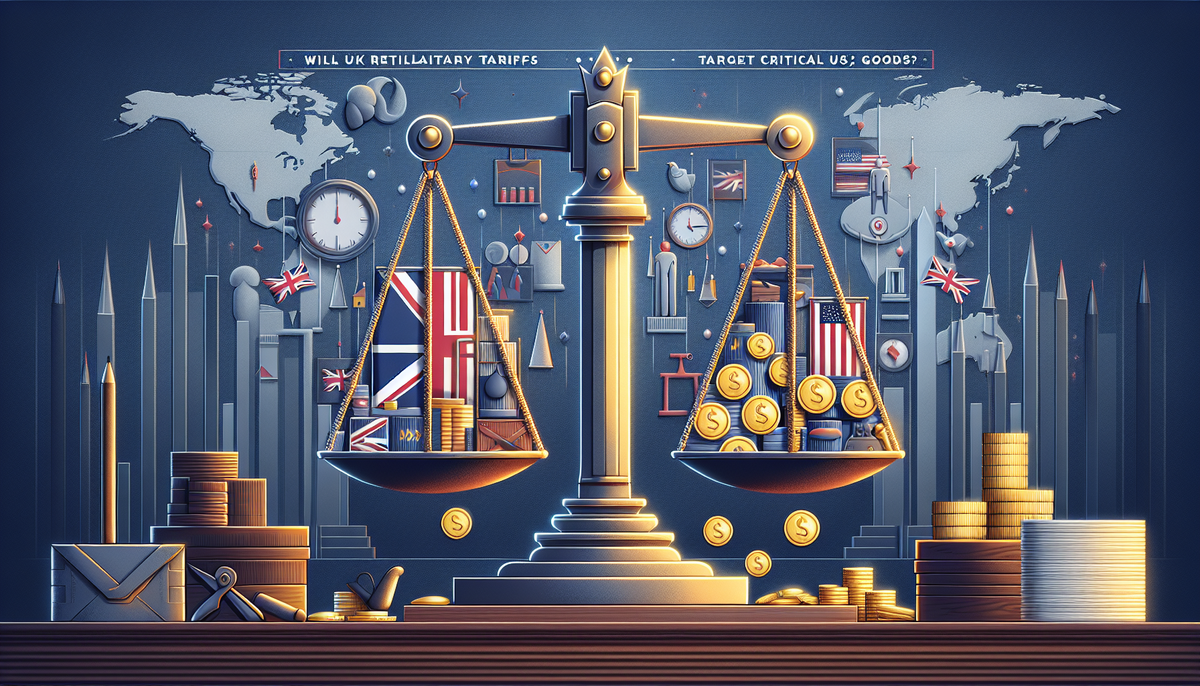Will UK Retaliatory Tariffs Target Critical US Goods?

Understanding the New Phase of UK-US Trade Tensions
The global trade landscape is rarely static, and recent announcements from the UK government have underscored this reality. With rising tensions and a potential trade war looming on the horizon, the UK is considering a list of US products that could be hit with retaliatory tariffs. This in-depth review explores the rationale, potential impacts, and broader economic implications of these measures.
The Context Behind Retaliatory Tariffs
The decision to outline a list of US products for potential tariffs comes amid a broader global climate of protectionism and trade negotiation challenges. Following President Donald Trump’s imposition of new import taxes targeting British exports, the UK government has signaled that it reserves the right to respond in kind if a mutual trade deal cannot be negotiated by the looming deadline. This strategic move is part of an effort to protect domestic industries and ensure that trade imbalances are addressed.
Key Factors Driving the Tariff Decision
There are several factors that have motivated the UK to consider retaliatory measures against US imports. Understanding these drivers helps provide insight into the emerging market trends and the broader economic outlook. Among these factors are:
- Trade Negotiation Deadlines: With a hard deadline set for negotiations and consultations concluding on May 1, there is immense pressure on policymakers to act decisively.
- Economic Impact: The UK government is mindful of how tariffs might affect overall economic growth, business investments, and the competitive landscape, especially when 27% of US imports come under scrutiny.
- Sector Vulnerabilities: Specific sectors such as manufacturing, automotive, and even consumer goods are more sensitive to tariff changes. The sample list includes items ranging from bourbon whiskey to crude oil.
- Political Pressures: Domestic political pressures and public sentiment, especially following Brexit debates and economic forecasts, also contribute to this decision-making process.
Examining the List of Potentially Tariffed US Products
The government has provided a sample list of goods that might face UK tariffs if a trade agreement isn’t reached. While the list spans 417 pages, the focus rests on products that make up a significant portion of imports but are expected to have a "more limited impact" on the domestic economy if taxed. Notably, these include:
- Children’s apparel and clothing items
- Pure bred horses
- Crude oil and energy products
- Firearms and defense-related goods
- Bourbon whiskey and premium spirits
While the inclusion of each product is based on balancing economic impact with political necessity, it highlights the nuanced approach the UK is taking to its trade policy in the face of countermeasures from the US.
Economic and Market Trends That Influence Tariff Policy
The emerging market trends suggest several dimensions upon which these new tariffs could exert significant influence:
- Inflationary Pressures: Imposing tariffs often results in increased prices for imported goods. In an already inflation-conscious global economy, this may drive up consumer prices and cost of living.
- Market Volatility: Stock markets tend to react sharply to geopolitical events. With significant sectors from machinery to car components on the line, market volatility could rise in anticipation of further trade disruptions.
- Fintech and Disruption: As traditional trade lanes feel the tremors of these new policies, fintech innovations and digital platforms may step in to offer alternative trading solutions and risk management strategies.
- Global Value Chains: With tariffs imposed on significant trade volumes, global supply chains might see a reshuffling. Business leaders are already evaluating alternative sourcing strategies to mitigate risks associated with these tariffs.
How Do Tariffs Impact Businesses and Consumers?
The implementation of tariffs is a double-edged sword. While they are intended to protect domestic industries, there are several potential downsides:
- Increased Costs for Businesses: Companies that rely on imported components may see cost increases, which could lead to higher final product prices.
- Consumer Price Hikes: Ultimately, any extra cost incurred by businesses is often passed onto consumers, reducing purchasing power and potentially dampening economic growth.
- Risk of Trade Wars: Tariffs are inherently retaliatory in nature. Escalating their use can lead to a series of countermeasures that affect global trade stability.
Trade Negotiations: The Road to Resolution
It is important to note that the decision to list US products for potential tariffs is not set in stone. UK Trade Secretary Jonathan Reynolds has been consulting extensively with industry stakeholders to gauge the true impact of these tariffs. If negotiators can secure a deal that lowers the 10% tariff imposed on nearly all UK exports, there is the possibility that the list will be frozen or abandoned altogether.
Key points in the negotiation process include:
- The potential alignment on technology trade, which may cover not just goods but also services and agricultural products.
- The UK government’s willingness to explore parallel avenues such as adjusting digital services taxes, particularly aimed at big tech firms.
- The emergency measure tied to the US import taxes, which suggests that there might be flexibility once broader discussions yield positive results.
Case Studies and Historical Precedents
Historically, trade wars and the imposition of tariffs have led to significant shifts in market dynamics. For example:
- US-China Trade War: The imposition of tariffs by both the US and China led companies to rethink their global supply chains, accelerate automation, and explore new west-to-east and east-to-west sourcing methods.
- EU Tariffs on Various Imported Goods: European countries have experienced moderate increases in consumer prices but have countered by promoting domestic industries and fostering innovation.
These case studies provide valuable insights for analysing the potential consequences of current tariff measures being considered by the UK. The dynamic interplay between economic pressures and political decision-making continues to showcase the complexity of global trade policies.
Strategies That Businesses Can Employ in Response
For business leaders, investors, and market analysts, understanding how to navigate the increasingly complex world of tariffs is critical. Here are some strategic suggestions for stakeholders:
- Diversification: Consider diversifying supply sources and markets to hedge against the risks inherent in trade disputes.
- Cost Management: Develop strategies to absorb increased import costs without transferring the entire burden to consumers immediately.
- Leverage Technology: Embrace digital transformation and fintech innovations to build more resilient and responsive business models.
- Engage in Policy Dialogue: Businesses are encouraged to actively participate in consultations and policymaking processes, ensuring that their voices and sector-specific needs are represented in governmental decisions.
The Broader Economic Outlook
The latest discussions around tariff adjustments are set against a backdrop of broader economic challenges – from ongoing inflation to stock market fluctuations – which are testing the resilience of the UK economy. The official forecaster of the government warns that a worst-case trade war scenario could reduce UK economic growth by 1%, severely impacting public finances and forcing potential revisions to tax policies or spending cuts.
Furthermore, global economic indicators suggest that in an interconnected world economy, unilateral protectionist measures rarely occur in isolation. There is every possibility that sectors outside the immediate focus of these tariffs could experience ripple effects emanating from both the direct and indirect consequences of elevated trade barriers.
Market Trends and Policy Innovations in a Trade War Context
Emerging trends in global trade highlight a shift towards more flexible, technology-driven approaches to market unpredictability. Key trends include:
- Increased Corporate Investment in Artificial Intelligence: Enhanced forecasting and adaptable decision-making processes are becoming essential in managing trade uncertainties.
- ESG and Sustainable Investments: Despite the turbulence of tariff impositions, many companies continue to pivot toward sustainable practices, seeing long-term value in ethical investments and innovation even in the face of short-term challenges.
- Adaptation of Global Supply Chains: Companies are reengineering their production and distribution networks to mitigate the adverse effects of future tariffs and trade barriers.
- Growth of Local Manufacturing Initiatives: Some businesses are rethinking their reliance on global trade by increasing local production, thereby reducing exposure to international trade volatilities.
Expert Insights and Analyst Perspectives
Economic experts have provided mixed opinions on the potential fallout from the UK’s proposed tariffs. While some argue that these measures may protect certain domestic industries, others warn of adverse impacts that might accelerate long-term economic challenges. Among the expert analyses are:
- Market Prognostications: Analysts predict a phase of prolonged uncertainty in which businesses must balance between short-term protectionist benefits and the potential long-term costs of global isolation.
- Policy Critiques: Critics point out that while selective tariffs can buffer domestic markets temporarily, they also risk creating retaliatory barriers that disrupt established trading relationships.
- Real-World Business Cases: Several UK-based companies have already begun scenario planning for a future in which bilateral or multilateral trade disputes become the norm rather than the exception.
What Lies Ahead for UK Trade Policy?
As discussions continue between the UK and US, the coming weeks will be critical in determining the shape of future trade policies. The following points summarize the potential trajectories:
- Negotiation Outcomes: A successful trade deal could neutralize the need for a retaliatory list, thus stabilizing market expectations.
- Policy Flexibility: The UK government has indicated that its approach may evolve based on ongoing consultations with industry stakeholders and economic data.
- Long-Term Strategy: Whether through technology investments, supply chain diversification, or renewed focus on domestic production, the overall strategy will likely blend both protective measures and forward-thinking economic reforms.
Conclusion: Navigating Uncertainty in a Shifting Trade Landscape
The potential imposition of retaliatory tariffs on US goods by the UK represents a decisive moment in international trade relations. While designed as a countermeasure to the US tariff on UK exports, these policies carry far-reaching implications that extend well beyond the immediate industries affected. By understanding the underlying economic principles, policy factors, and real-world case studies, businesses and investors can better position themselves in a potentially volatile market environment.
This analysis underscores the importance of adaptability and strategic foresight as key components of success in today’s interconnected global economy. In the end, staying informed and agile in response to these evolving trade measures will be crucial for market participants, while policymakers must strive to balance national interests with the broader imperatives of global commerce.
Key Takeaways
- The UK is evaluating a comprehensive list of US products as potential targets for retaliatory tariffs amid ongoing trade disputes.
- Economic factors such as inflation, market volatility, and supply chain adjustments are at the forefront of this decision-making process.
- Both policymakers and business leaders are urged to adopt strategies that minimize disruption and safeguard long-term economic growth.
- The future of these tariffs hinges on swift and effective trade negotiations, with a firm deadline driving urgency in policy adjustments.
How Businesses Can Prepare
Given the uncertain timeline and potential for significant economic impact, businesses should consider initiating the following measures:
- Conduct thorough risk assessments to understand how increased import costs could affect margins.
- Explore alternative sourcing strategies and strengthen local supply chains to reduce dependency on US imports.
- Engage with industry associations and governmental consultations to ensure that sector-specific concerns are voiced.
- Invest in digital transformation and fintech solutions to enhance operational efficiency and market responsiveness.
Final Thoughts
The unfolding saga of UK retaliatory tariffs against US goods serves as a timely reminder of the delicate balance between national policy and global economic interdependence. As trade negotiations continue and market conditions evolve, the ability to respond with agility will determine which companies thrive and which may struggle under new economic pressures.
For professionals, investors, and business leaders, staying updated on these trends and strategically planning for potential disruptions is not just prudent—it is essential for long-term success in an ever-changing global marketplace.



Comments ()